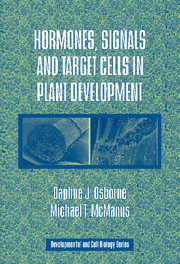Book contents
- Frontmatter
- Contents
- Preface
- 1 Introduction
- 2 Hormones and Signals: Identification and Description of Signalling Molecules
- 3 Cell-to-Cell Signalling: Short and Long Distance
- 4 Population Diversity of Cell Types and Target Identification in Higher Plants
- 5 Flexibility of Cell Types and the Target Cell Status
- 6 Terminally Committed Cell Types and the Target Status
- 7 The Mechanisms of Target Cell Perception and Response to Specific Signals
- 8 Hormone Action and the Relief of Repression
- 9 The Phenomenon of Hormonal Cross-Talk
- References
- Index
9 - The Phenomenon of Hormonal Cross-Talk
Published online by Cambridge University Press: 06 August 2009
- Frontmatter
- Contents
- Preface
- 1 Introduction
- 2 Hormones and Signals: Identification and Description of Signalling Molecules
- 3 Cell-to-Cell Signalling: Short and Long Distance
- 4 Population Diversity of Cell Types and Target Identification in Higher Plants
- 5 Flexibility of Cell Types and the Target Cell Status
- 6 Terminally Committed Cell Types and the Target Status
- 7 The Mechanisms of Target Cell Perception and Response to Specific Signals
- 8 Hormone Action and the Relief of Repression
- 9 The Phenomenon of Hormonal Cross-Talk
- References
- Index
Summary
In the last two chapters, discussion has been concerned with the evidence for specific hormone receptors and the downstream signalling events in cells that form part of the transduction chain initiated by the binding of a ligand (the hormone) to its respective receptor. Each major plant hormone has been considered and classified as a separate operational entity, but it is clear that while the same hormone can have different effects in different tissues, a similar response in the same tissue can also be brought about by more than one hormone, the interactions involved being highly dependent upon the genetic background of the tissue in question. With the unravelling of intracellular signalling downstream of hormone perception, it is now becoming clear that more than one signal can utilise a particular transduction pathway. In this final chapter, we refer to examples of such apparently duplicated hormonal responses and how this cross-talk in perception and signalling has been revealed through the use of specific phenotypically expressed mutants. The list is not exhaustive but it serves to illustrate the level of flexibility that a cell can sustain, combined with the basic concept of every cell as an individual target cell.
It has become evident that plants are quite versatile in the cross-talk of their molecular communication language, as represented by situations where one hormone can substitute in function for another.
- Type
- Chapter
- Information
- Hormones, Signals and Target Cells in Plant Development , pp. 198 - 204Publisher: Cambridge University PressPrint publication year: 2005



